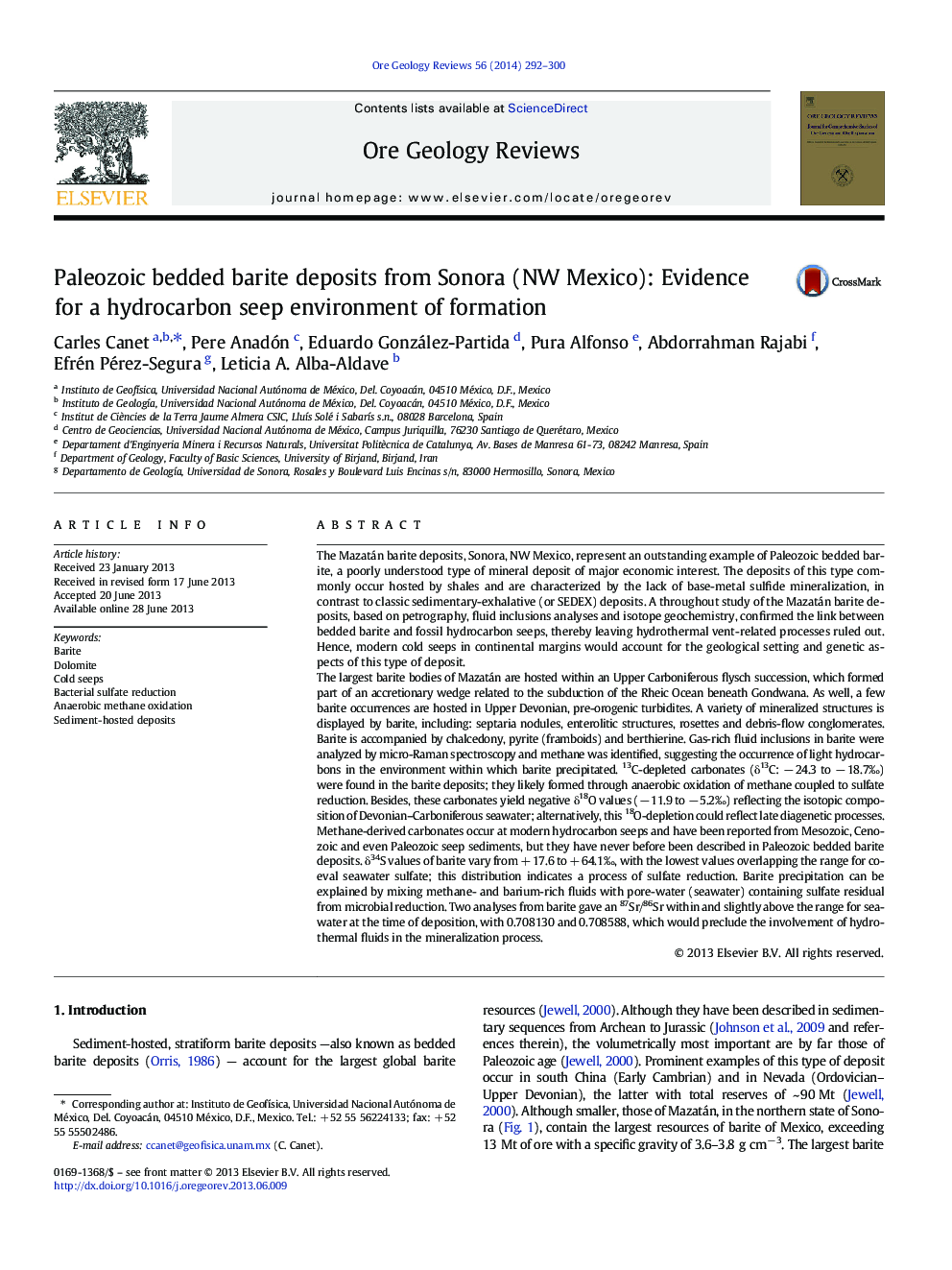| کد مقاله | کد نشریه | سال انتشار | مقاله انگلیسی | نسخه تمام متن |
|---|---|---|---|---|
| 4697435 | 1637247 | 2014 | 9 صفحه PDF | دانلود رایگان |

• Paleozoic bedded barite deposits were formed by seafloor hydrocarbon seepage.
• Textures, minerals and isotope ratios are similar to those of modern methane seeps.
• Carbonates are 13C-depleted and formed through anaerobic oxidation of methane.
• Raman analysis supports the occurrence of CH4 during barite crystallization.
• Barite forms from Ba-rich fluids plus sulfate residual from microbial reduction.
The Mazatán barite deposits, Sonora, NW Mexico, represent an outstanding example of Paleozoic bedded barite, a poorly understood type of mineral deposit of major economic interest. The deposits of this type commonly occur hosted by shales and are characterized by the lack of base-metal sulfide mineralization, in contrast to classic sedimentary-exhalative (or SEDEX) deposits. A throughout study of the Mazatán barite deposits, based on petrography, fluid inclusions analyses and isotope geochemistry, confirmed the link between bedded barite and fossil hydrocarbon seeps, thereby leaving hydrothermal vent-related processes ruled out. Hence, modern cold seeps in continental margins would account for the geological setting and genetic aspects of this type of deposit.The largest barite bodies of Mazatán are hosted within an Upper Carboniferous flysch succession, which formed part of an accretionary wedge related to the subduction of the Rheic Ocean beneath Gondwana. As well, a few barite occurrences are hosted in Upper Devonian, pre-orogenic turbidites. A variety of mineralized structures is displayed by barite, including: septaria nodules, enterolitic structures, rosettes and debris-flow conglomerates. Barite is accompanied by chalcedony, pyrite (framboids) and berthierine. Gas-rich fluid inclusions in barite were analyzed by micro-Raman spectroscopy and methane was identified, suggesting the occurrence of light hydrocarbons in the environment within which barite precipitated. 13C-depleted carbonates (δ13C: − 24.3 to − 18.7‰) were found in the barite deposits; they likely formed through anaerobic oxidation of methane coupled to sulfate reduction. Besides, these carbonates yield negative δ18O values (− 11.9 to − 5.2‰) reflecting the isotopic composition of Devonian–Carboniferous seawater; alternatively, this 18O-depletion could reflect late diagenetic processes. Methane-derived carbonates occur at modern hydrocarbon seeps and have been reported from Mesozoic, Cenozoic and even Paleozoic seep sediments, but they have never before been described in Paleozoic bedded barite deposits. δ34S values of barite vary from + 17.6 to + 64.1‰, with the lowest values overlapping the range for coeval seawater sulfate; this distribution indicates a process of sulfate reduction. Barite precipitation can be explained by mixing methane- and barium-rich fluids with pore-water (seawater) containing sulfate residual from microbial reduction. Two analyses from barite gave an 87Sr/86Sr within and slightly above the range for seawater at the time of deposition, with 0.708130 and 0.708588, which would preclude the involvement of hydrothermal fluids in the mineralization process.
Figure optionsDownload as PowerPoint slide
Journal: Ore Geology Reviews - Volume 56, January 2014, Pages 292–300